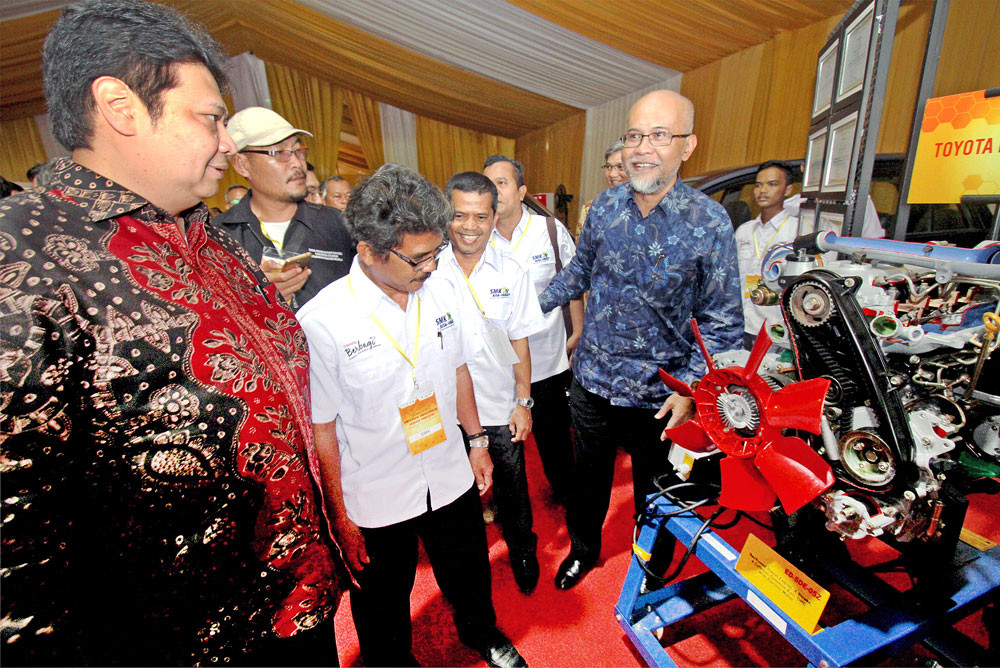Popular Reads
Top Results
Can't find what you're looking for?
View all search resultsPopular Reads
Top Results
Can't find what you're looking for?
View all search resultsCar making is not for everyone
Change text size
Gift Premium Articles
to Anyone
 Industry Minister Airlangga Hartarto (left) talks to Toyota Motor Manufacturing Indonesia (TMMIN) president director Warih Andang Tjahjono (right) while looking at a machine made by vocational students in Sukabumi, West Java. Toyota Indonesia, the local arm of Japanese automotive giant Toyota, donated cars and machineries to vocational high schools. (Antara/Yulius Satria Wijaya)
Industry Minister Airlangga Hartarto (left) talks to Toyota Motor Manufacturing Indonesia (TMMIN) president director Warih Andang Tjahjono (right) while looking at a machine made by vocational students in Sukabumi, West Java. Toyota Indonesia, the local arm of Japanese automotive giant Toyota, donated cars and machineries to vocational high schools. (Antara/Yulius Satria Wijaya)
I
s car making business for everyone? Just look at Vingroup, Vietnam's heavyweight conglomerate, which is in the development stage of producing Vietnam's first national car. Vingroup doesn’t take it lightheartedly in preparing this project.
They partner with the powerhouses in the industry such as Pininfarina for design and BMW for technology. Production facilities are also being prepared in the homeland country. Vingroup deserves credit for seriously orchestrating a solid interaction of design-technology-production.
But business is still about making revenue and/or profit. Will the locally made car bring in success economically? In Indonesia, a dream of having a locally made and branded car (mobnas) remains. If making mobnas is indeed worth doing, is there a winning strategy to lock its success?
As with any other businesses, any local car maker firstly needs to determine the right car (what) that will be offered to which customers (who). The right match between what to offer and customers’ needs will likely result in success.
The current gasoline car industry suggests all customers’ needs have been satisfied by the available numerous cars with many brands, as studies confirm. Entering the fully-developed car industryis not easy. Does the world really need a new branded car?
Based on knowledge of market and knowledge of technology, even a decade ago the automobile industry was already crowded with players competing in the same market with the relatively same technology, as shown in the 2009 study by Christian Terwiesch and Karl Ulrich.
Fast thinking will guide the local car maker not to enter the current market with the same car using the same technology. There is an iron law in the form of performance over price ratio to beat against the aristocrats in the industry. Offering either typical passenger or commercial cars to the same market will lead to regret, unless the locally made and branded cars come up with a superior ratio of performance over price than the existing cars.
For passenger cars, the local car maker needs to see what more is needed to improve traveling in or out of town. In addition, there is also the emotional need to show off one’s identity while driving.
Motorists have different degrees of importance to the functional and emotional needs of their cars. Previous studies of people who want affordability shows functionality is more important to them than emotion, in the ratio of 2 to 1. Hypothetically, this ratio will change for those seeking prestige and no longer dispute the car price; thus the emotional need becomes dominant.
Hence, the choice for the local car maker becomes clear, that is to offer functional cars to users with limited purchasing power and cars with more emotional value to those with higher purchasing power. It is evident from Indonesia’s domestic market that vehicles priced up to Rp 300 million (about US$21,400) are heavily favored. The low cost green car (LCGC), multi-purpose vehicle (MPV), low single utility vehicle (LSUV), and city cars are within this segment. They contributed 50 percent of the total car sales in 2018, according to the Association of Indonesian Automotive Manufacturers (Gaikindo).
To compete in functionality for cars with prices less than Rp 300 million, a national car project requires the courage to lower the price so that performance/price ratio is much higher than competitors, assuming performance is not sacrificed. The question is how low can the price go? Best practice suggests that newcomers to the industry need to offer performance to price ratio of 2.0 or higher than that of competing cars.
The same thing happens to commercial vehicles. Due to its importance on functionality, local automobile makers need to offer a superior ratio of performance over price. Lowering the price requires the capability of car makers to reduce costs. Still lacking support from a solid supply network and being in the introduction stage, local manufacturers find it very difficult to compete against cost. Infeasibility becomes the main problem facing the local maker in making low cost cars without sacrificing performance.
The situation will be “suicidal” for local manufacturers if homemade cars are positioned as premium cars. The “underdog mentality” among car makers in the Asian countries make them reluctant to make local products, as Arnoud De Meyer and Sam Garg wrote in 2005. Distrust still arises from the Asian community who still believe in foreign brands. Foreign brands still have the advantage to perform emotional job better, either personal (to be enjoyed by the users themselves) and social (to be delivered to others).
Overall, producing locally made and branded car employing the same technology (gasoline platform) to the existing market seems to be a “No-Go” decision.
Some countries are already committed to ditch gasoline cars in favor of electric cars as soon as 2025; these can be fully electric or hybrid cars. Giants in the automotive industry are pouring billions of US dollars and Euros to make electric cars accessible to many people. Some unfamiliar names have also presented serious initiatives to produce electric cars. Democratization in car-making seems to be in the works now. Will local players in Indonesia capitalize on this current wave of electrifying cars?
The situation is much more uncertain than entering the existing market with the gasoline platform. Like it or not, the car industry will still be dominated by the big names. The users in the existing market will still trust and rely on them.
Competing against the established players is surely not an easy journey. When existing players have satisfactorily met customers’ needs, the new player should look for new tasks or needs to fulfill – beyond existing consumers. Find them and serve them well.
***
This writer is an advisor in operations and decisions at the Prasetiya Mulya Business School.










